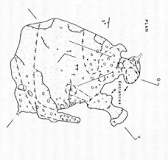Cub Cave is one of the few caves in San Antonio, Texas that are ungated. Only so much history on Cub Cave is documented online or offline. This news article will explain the history, geology, and biology behind Cub Cave. Michael Mixerr will explain everything.
Cub Cave is actually a sinkhole which literally turns into a cave as you travel further inside. You are greeted by a large entrance when you first approach this cave. A 14 meter collapse sinkhole opens as a large entrance that continues southward into a 20 meter diameter, 8½ feet high room. A 1 meter hole near the western wall of this cave leads to 3 different passages or in this case three levels of passages. The passages are primarily spaces between collapsed blocks and the cave wall. All levels pinch in breakdown or flowstone-covered breakdown. Height of these passage vary in size and diameter. These cave walls are flowstone-covered. [Ref: TSS Files, The Caves of Bexar County, 1960]
Cub Cave is located in the Balcones Fault Zone and the recharge zone of Edwards Aquifer. My San Antonio claims Cub Cave receives large quantities of rainwater runoff due to being one of the recharge caves for Edwards Aquifer in Bexar County. High volumes of runoff water been reported to have come from Cub Cave. (Ref: https://www.mysanantonio.com/news/local/communities/stone-oak/article/Stone-Oak-Park-offers-urban-refuge-5266700.php)

Because this cave is located in the Balcones Fault Zone and Edwards Aquifer, there are uneven breakdown floors. All the rooms are not level. There are areas where there are uneven surfaces. So climbers and cavers need to be aware.
Measurements of the cave entrance are 14 meters in diameter. A 14 meter collapse sinkhole opens as a large entrance that continues southward into a 20 meter diameter, 8½ feet high room. The entrance has a flowstone overhang what has been for both rescue training and vertical climbing by cavers. That is what the overhanging entrance has been used for in the past and present.
Cub Cave serves as an animal shelter which is home to spiders, harvestmen (prob. Leiobunum townsendii), snails, bats, cave crickets (Ceuthophilus sp.), and a slimy salamander (Plethodon glutinosus albagula). Wildlife from Mud Creek can be found inhabiting this cave. 
The history, discovery, and exploration of Cub Cave coincide with the discovery of Bear Cave. James Jasek discovered Cub Cave while exploring Bear Cave just 100 meters away in 1963. He discovered that there is a possibility that Bear Cave and Cub Cave connect with each other. Now the first known documentation of Cub Cave was on a 1964 location map of Bear Cave surveyed by James Jasek. This cave was surveyed again by Allan Cobb and Joe Ivy on August 17, 1985. [Ref: The Caves of Bexar County (Second Edition), George Veni]
Today Cub Cave is now property of Stone Oak Park. Cub Cave is one of the few ungated caves in San Antonio, Texas and remains so today.
Cub Cave is located at 20395 Stone Oak Parkway, San Antonio, Texas, US 78258.
Mixerr Reviews was a news blog/local business from Austin, Texas, US that operated from 2012 to 2023. This blog is no longer operational and has been discontinued since Michael Mixerr is currently a writer, narrator, and content curator for Bout Dat Online.
Monday, November 16, 2020
History of Cub Cave in San Antonio, Texas explored and explained by Michael Mixerr.
Subscribe to:
Post Comments (Atom)
No comments:
Post a Comment